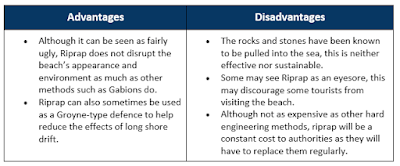‘Soft engineering works in
harmony with the natural environment and is effective in protecting the coast’.
To what extent do you agree
with this view? (15)
Soft engineering is a form
of coastal management that works with the natural environment while effectively
protecting the coast from coastal erosion. Soft engineering’s use of natural
resources and materials allows its methods to work in harmony with a coast’s
natural environment. This is because the natural materials used cause little to
no disruption to a beach’s appearance and environment. Soft engineering schemes
can be very effective in protecting the coast, an example of this is Pevensey
Bay in East Sussex. A 30 million pound coastal protection scheme was launched
in 2000 at Pevensey Bay. The scheme is predicted to last for up to 25 years.
Soft engineering is the main form of coastal protection featured as part of the
scheme. The scheme has so far effectively protected the Pevensey Bay coast for
16 years.
Beach Nourishment is one of
the methods used at Pevensey Bay. This involves using a dredger to placing up
to 40,000 tonnes of new shingle onto the beach each summer in order to replace
the shingle that has been lost through longshore drift. The new shingle deepens
the beach which allows it to provide a buffer to incoming waves to prevent
erosion such as hydraulic action happening to the top of the beach. The longer
the waves have to travel along the beach the less energy they have when they
reach the top of the beach. This soft engineering method also works in harmony
with Pevensey Bay’s natural environment as the use of natural shingle causes no
disruption to the beach’s appearance or character.
Beach Reprofiling is another
method of coastal defence used at Pevensey Bay. This method uses bulldozers to
move shingle back to its original position on the beach after being moved along
the beach by longshore drift. Beach can be re-shaped after storms or prepared
for predicted storms using this method of soft engineering. Beach Reprofiling
is very effective at Pevensey Bay, at least one bulldozer is kept at the beach
at all times with others available to be brought in when needed. This means
that the beach’s shape can be kept intact at all times, this allows the beach
to defend itself against the energy of incoming waves therefore protecting the
15,000 properties and 2 nature reserves situated alongside the Pevensey Bay
coast. Beach Reprofiling also works harmoniously with the natural environment
as the beach’s amenity value is not damaged as the method uses natural
resources to carry out its coastal protection.
Overall I agree with the view that ‘Soft engineering works in harmony with the natural environment and is effective in protecting the coast’ and I believe that the successful protection of Pevensey Bay using soft engineering is evidence of this. However some people may argue that Hard Engineering can provide more effective methods of coastal defence such as Sea Walls, Groynes and Gabions. Coastal Areas such as Hunstanton in Norfolk have chosen to protect their beaches with methods of Hard Engineering. Although hard engineering can provide an effective short-term solution to coastal erosion in the long term its methods are unsustainable due to their expenses and maintenance needs. In addition to this hard engineering methods commonly use man-made artificial resources to protect coasts, therefore they do not work in harmony with the natural environment unlike soft engineering methods.


















